Volunteering Statistics for 2024: Explore Key Insights
Volunteering takes many forms. Running a bake sale to raise money for an elementary school, planting trees in a community park with a conservation nonprofit, and caring for a neighbor with an illness are all types of volunteering.
Volunteering is part of the fabric of our society, ensuring we care for our neighbors and support the causes we care about. This guide explores key volunteering terms, trends, and statistics to help paint a clear picture of the current state of volunteering. Here’s what we’ll cover:
- Key volunteering terms
- General volunteer statistics
- Corporate volunteering statistics
- Volunteer grants statistics
- Volunteer demographics
- Volunteer satisfaction statistics
- Health benefits of volunteering statistics
This guide is for anyone invested in learning about or improving the state of volunteering—whether volunteer coordinators, corporate volunteer managers, or volunteers themselves. These statistics will help you understand current volunteer trends and give context to your efforts to help improve the volunteer experience.
Key volunteering terms
Before diving into our volunteering statistics, let’s review some key terms relevant to volunteering to clarify current trends.
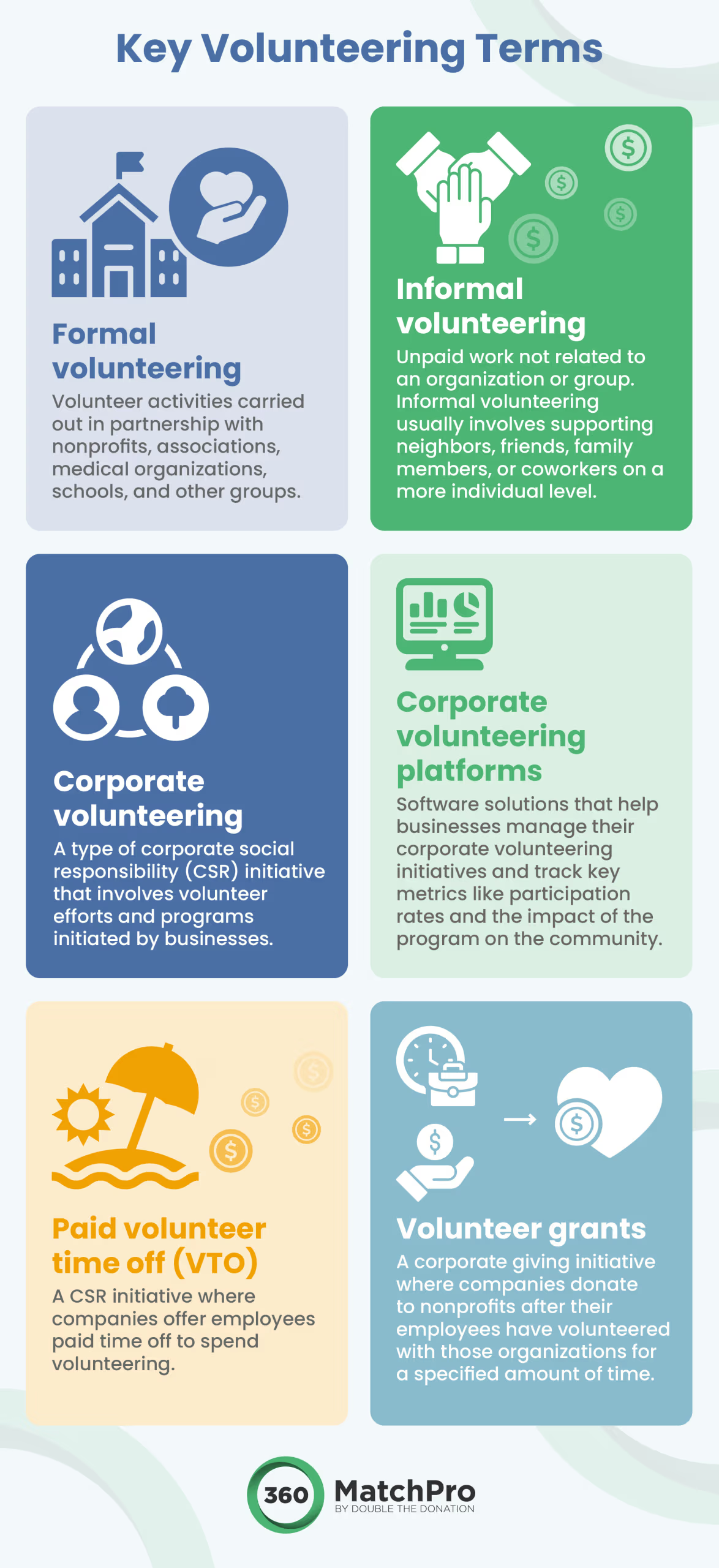
Formal volunteering
Definition: Volunteer activities carried out in partnership with nonprofits, associations, medical organizations, schools, and other groups.
Example: Formal volunteering could include helping cook meals at a community kitchen, shelving books at a library, or entertaining sick children at a hospital.
Informal volunteering
Definition: Unpaid work not related to an organization or group. Informal volunteering usually involves supporting neighbors, friends, family members, or coworkers on an individual level.
Example: You get together with a group of fellow community members to cook meals for a family with a young child fighting cancer.
Corporate volunteering
Definition: A corporate social responsibility (CSR) initiative that involves volunteer efforts initiated by businesses.
Example: A group of employees visits a senior center to help manage an afternoon craft activity and interact with residents.
Corporate volunteering platforms
Definition: Software solutions that help businesses manage their corporate volunteering initiatives and track key metrics like participation rates and program impact.
Example: Selflessly and POINT are examples of corporate volunteering and giving platforms that make it easy to plan and track CSR initiatives. Explore our guide to corporate volunteering platforms to understand the top features to look for in these tools.
Paid volunteer time off (VTO)
Definition: A CSR initiative where companies offer employees paid time off to spend volunteering.
Example: Warner Media offers employees up to 40 hours of paid time off to spend volunteering with qualifying organizations each year. Check out even more top VTO opportunities here!
Volunteer grants
Definition: Also known as Dollars for Doers, volunteer grants are a corporate giving initiative where companies donate to nonprofits after their employees have volunteered with those organizations for a specified amount of time.
Example: Walmart and Sam’s Club offer employees $10 per hour volunteered (up to $1,000) for the organizations they volunteer at.
General volunteer statistics
Now that we’ve laid the foundation for key volunteer topics, let’s explore a few statistics and trends about the general state of volunteering.
- Most volunteering is informal.
- Source: UN Volunteers
- According to the State of the World’s Volunteerism Report (SWVR), 14.3 percent of the global population participated in informal volunteering in 2022, while 6.5 percent of working-age people worldwide engage in formal volunteering via an organization or association.
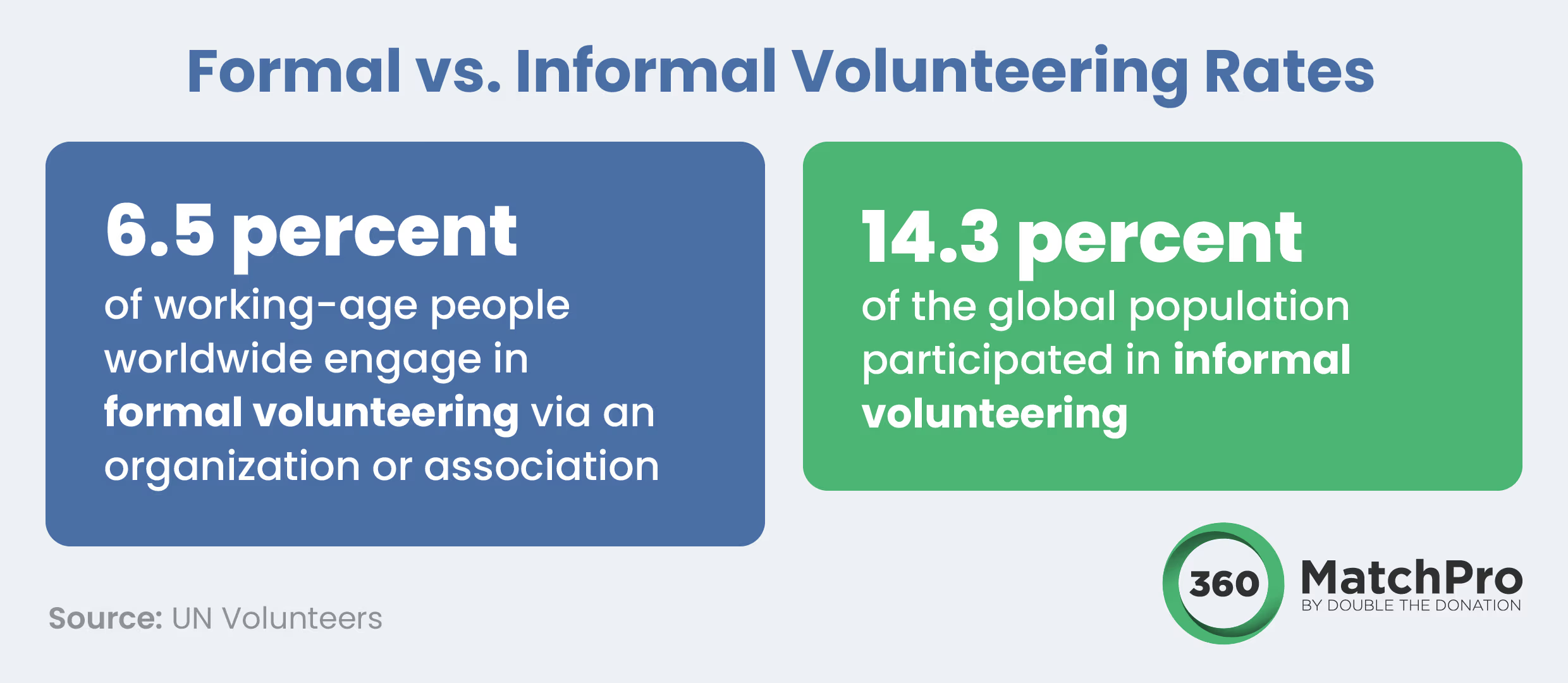
- More than 60.7 million Americans formally volunteered in 2021 during the height of the pandemic, and over 124.7 million Americans informally volunteered.
- Source: United States Census Bureau
- Formal volunteering rates are decreasing in many states.
- Source: AmeriCorps
- From 2017-2021, rates of formal volunteering declined in most states. Informal volunteering stayed more consistent, with many states seeing less drastic variations.
- The current value of a volunteer hour is $31.80.
- Source: Independent Sector
- Nonprofits often operate on tight budgets. For example, the median operating margin of nonprofit hospitals and health systems in 2022 was a mere 0.2%. Volunteers provide a massive amount of value for nonprofits because they offer their passion, time, and energy without expecting monetary compensation.
- About 1/3 of the nonprofit workforce is made of volunteers.
- Source: Philanthropy Roundtable
- Staffing is a constant challenge for the nonprofit sector, and volunteers often step in to provide the unpaid support needed to keep organizations running.
Key takeaways: Volunteer work keeps the nonprofit sector in motion and also plays a significant role in the way we interact with our fellow community members. However, disruptions to volunteer work, like the COVID-19 pandemic, cause instability in the sector.
Volunteer managers should keep this in mind when designing volunteer opportunities and reaching out to new audiences. For example, coordinators could consider offering more virtual or flexible opportunities to appeal to those who want to participate from home or have busy schedules.
Corporate volunteering statistics
Corporate volunteerism is on the rise as businesses seek to improve their reputations, customer retention rates, and employee satisfaction scores through workplace giving and other CSR initiatives. These statistics can help justify the creation of a corporate volunteer program at your workplace.
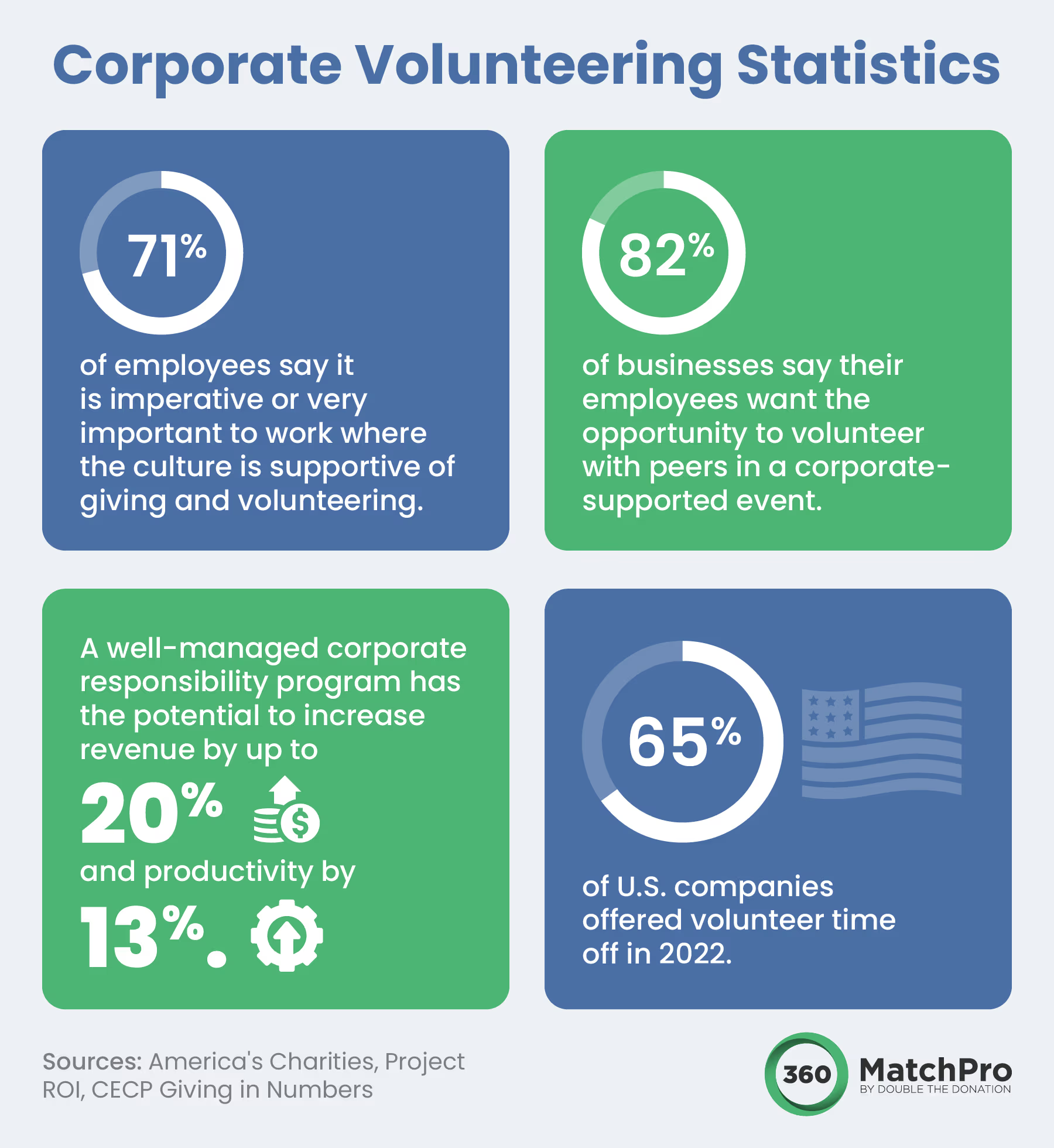
- 71% of employees say it is imperative or very important to work where the culture is supportive of giving and volunteering.
- 82% of businesses say their employees want the opportunity to volunteer with peers in a corporate-supported event.
- A well-managed corporate responsibility program has the potential to increase revenue by up to 20% and productivity by 13%.
- Source: Project ROI
- 65% of U.S. companies offered volunteer time off in 2022.
- Source: CECP Giving in Numbers
Key takeaways: Corporate volunteerism offers multifaceted benefits:
- Businesses benefit from improved employee retention, customer satisfaction, and public image.
- Employees benefit from having opportunities to engage with their community and peers on a deeper level.
- Customers benefit from being able to support organizations that contribute to positive social change.
- Nonprofits and charitable organizations benefit from receiving increased support for their missions.
Businesses should also actively promote these programs to their employees to encourage awareness and participation. Awareness is often one of the largest barriers to participation in CSR. For example, 78% of donors are unaware of whether their employer offers a matching gift program.
Companies can improve awareness by spotlighting volunteer opportunities in their employee newsletters or leveraging a workplace giving platform to plan and promote group volunteer opportunities.
Volunteer grants statistics
As mentioned, volunteer grants can be an effective way for companies to encourage employee volunteerism and provide value for nonprofits. These statistics from Double the Donation reveal the impact and popularity of volunteer grants.
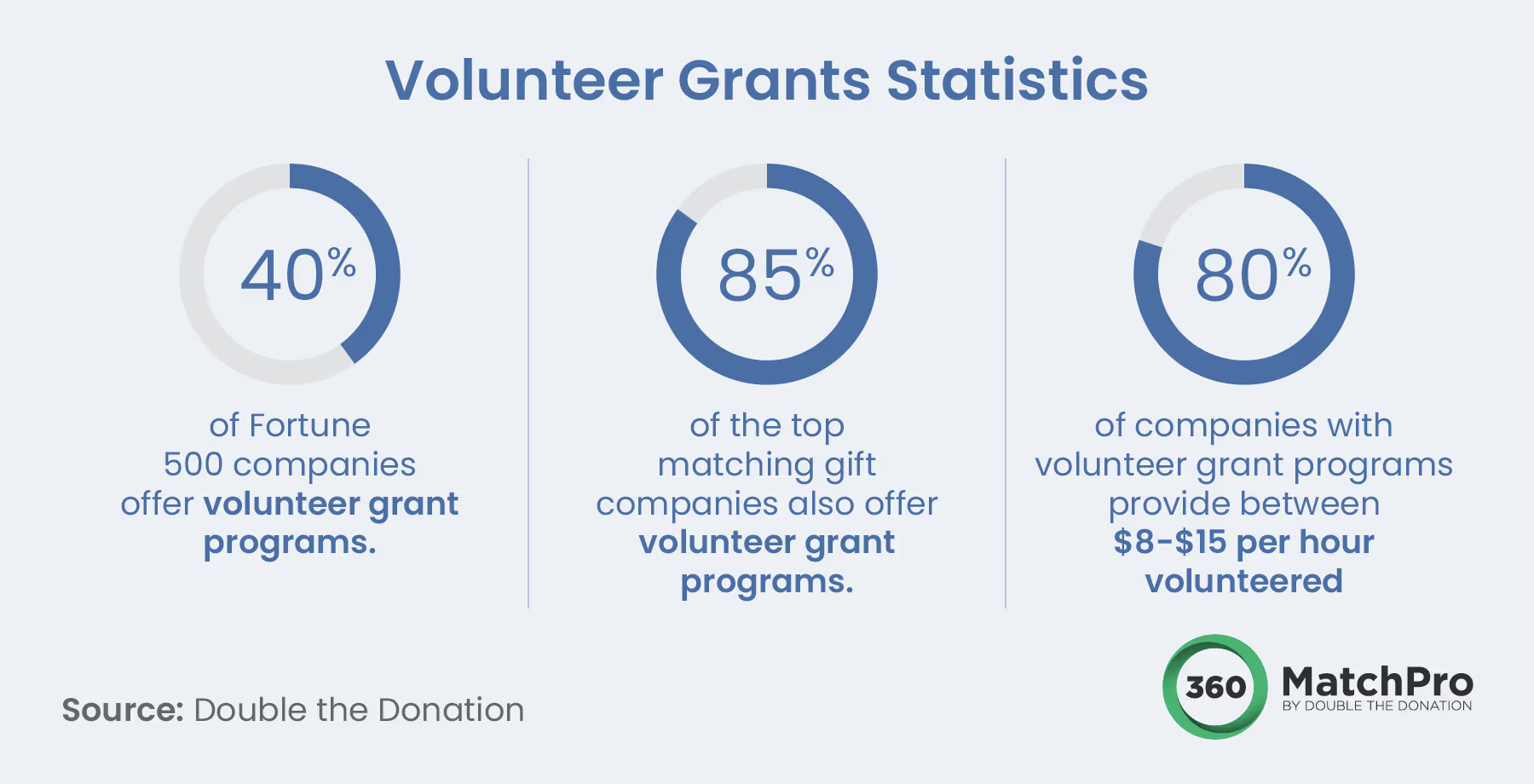
- 40% of Fortune 500 companies offer volunteer grant programs.
- Source: Double the Donation’s Review of Fortune 500 Companies’ Employee Giving Programs
- 85% of the top matching gift companies also offer volunteer grant programs.
- Source: Double the Donation’s Analysis of Top Matching Gift Programs
- 80% of companies with volunteer grant programs provide between $8-$15 per hour volunteered
- Source: Double the Donation’s Analysis of Top Matching Gift Programs
Key takeaways: If you’re interested in starting a volunteer grant program, you’re in good company. Top businesses around the world see the value these programs have to give back to the community while supporting causes that matter to employees.
Explore our roundup of top volunteer grant companies to get inspiration for your program.
Volunteer time off statistics
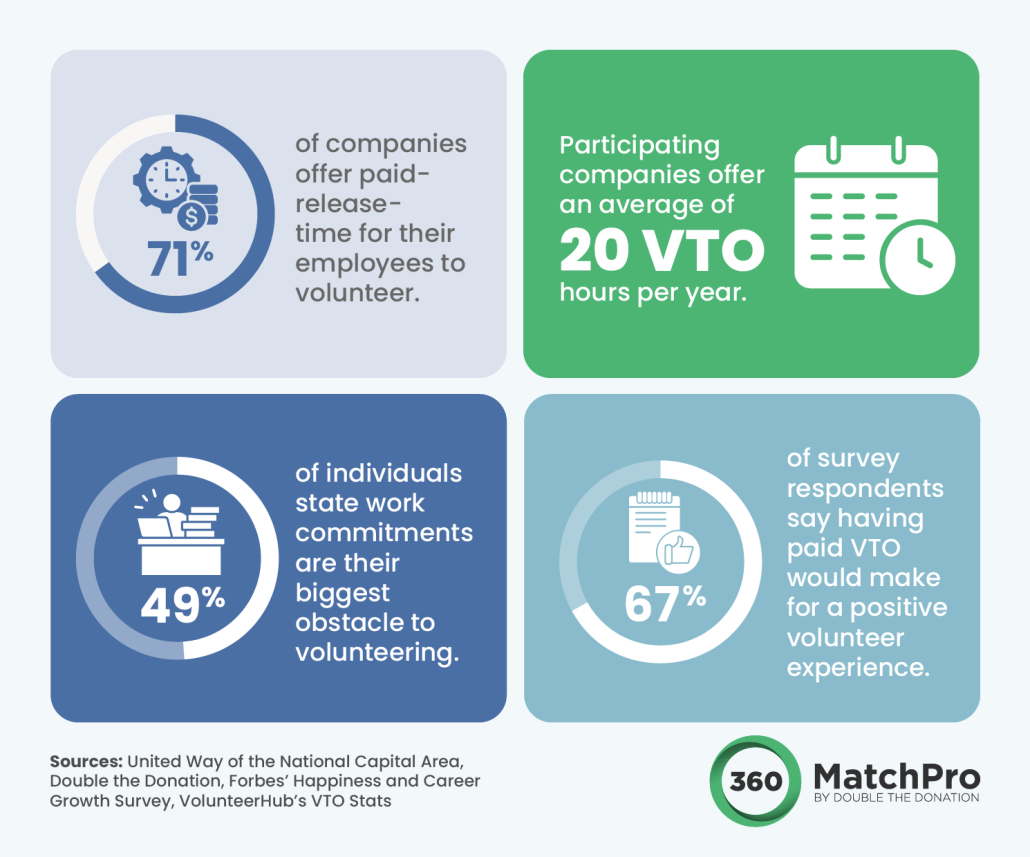
Volunteer time off is another of the most popular forms of corporate volunteerism, and promoting the opportunities is essential for success. These statistics from Double the Donation also demonstrate the benefits of these programs and how your team can maximize their value.
- 65% of companies offer paid-release-time for their employees to volunteer.
- Source: United Way of the National Capital Area’s VTO by the Numbers
- Participating companies offer an average of 20 VTO hours per year.
- Source: Double the Donation’s Volunteer Time Off Statistics
- 49% of individuals state work commitments are their biggest obstacle to volunteering.
- Source: Forbes’ Happiness and Career Growth Survey
- 67% of survey respondents say having paid VTO would make for a positive volunteer experience.
- Source: VolunteerHub’s VTO Stats
Key takeaways: Offering employees paid time off to partake in nonprofits’ volunteer activities is becoming an increasingly popular way for companies to engage their staff and give back at the same time. As a result, employees are more likely to support your cause with their time when it’s being compensated.
Interested in learning more about volunteer time off and other corporate volunteering opportunities? Check out Double the Donation Volunteering!
Volunteer demographics
Understanding who volunteers are can help volunteer managers create marketing campaigns that appeal to their interests. Here are a few demographic-related statistics to be aware of to better understand your target audience.
- Generation X has the highest rate of formal volunteering of all generations, while Baby Boomers have the highest rates of informal volunteering (59%).
- Source: U.S. Census Bureau
- Utah is the U.S. state with the highest rates of volunteerism.
- Source: AmeriCorps
- 26.5% of males and 33.8% of females volunteer in America.
- Source: AmeriCorps
Key takeaways: In general, volunteers tend to be older women, but every organization is unique. Maintain accurate volunteer records with the help of your volunteer management system (VMS) to get to know your specific audience. Ask volunteers for demographic information when they first register online and ensure this data flows directly into your VMS.
Using this information, develop volunteer personas to enhance your marketing outreach. Personas are fictional representations of audience segments. They can support your marketing efforts by allowing you to create tailored marketing content that appeals to different groups. For example, you might create a persona for volunteers who are college students, and use the local university’s email list to recruit new participants.
Volunteer satisfaction statistics
What causes volunteers to get involved and stay engaged? These data points paint a picture of volunteers’ motivations.
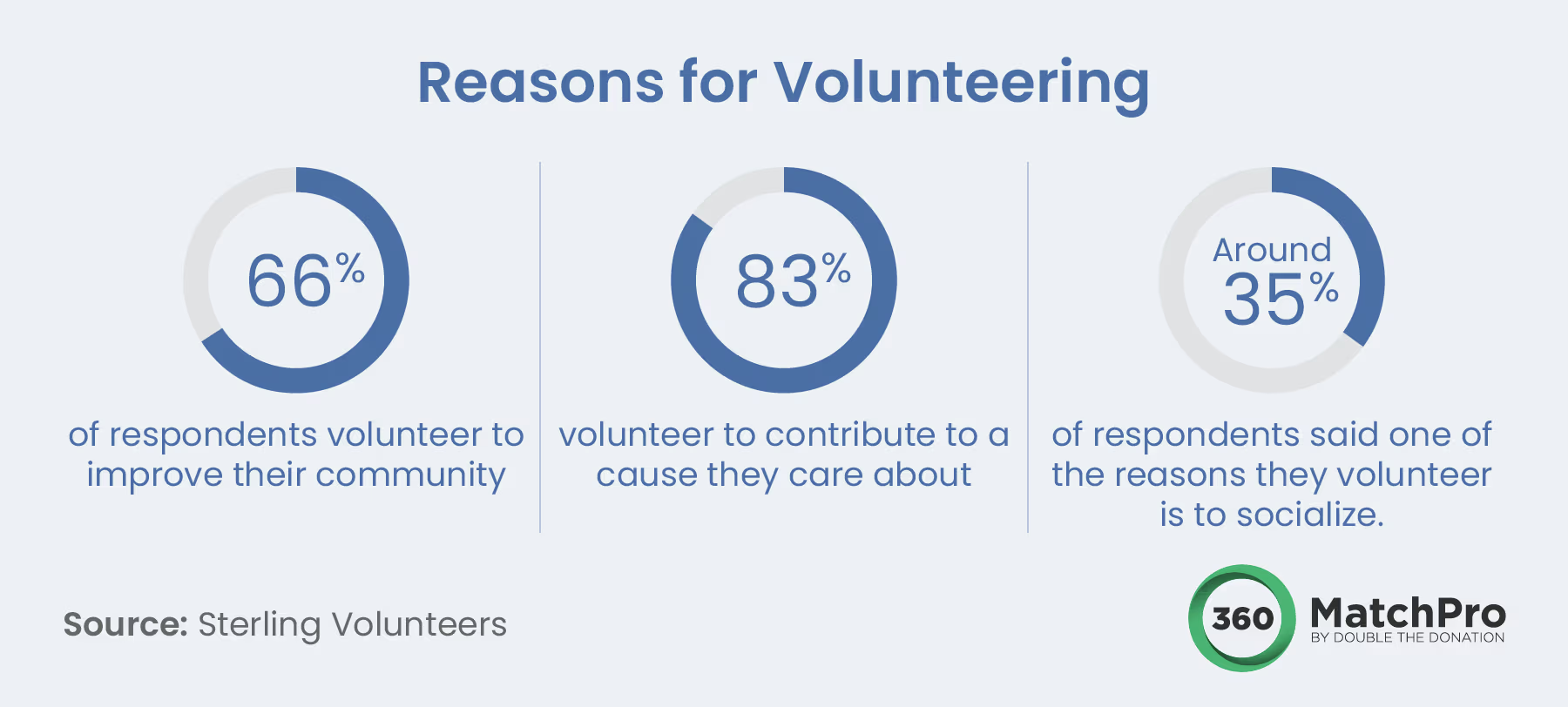
- 66% of respondents volunteer to improve their community, 83% do so to contribute to a cause they care about, and more than 35% of respondents said one of the reasons they volunteer is to socialize.
- Source: Sterling Volunteers
- Key factors influencing volunteer satisfaction include recognition, a respectful and trustworthy culture, and a feeling of belonging to a group.
- For the past eight years, volunteer managers have noted that recruitment is their greatest challenge.
Key takeaways: While passion for your mission and a desire to help others are strong motivators, don’t forget about the social aspect of volunteering. Many community members get involved with volunteering to make or meet up with friends. Emphasize social aspects of your volunteer experience, such as monthly dinners, your exclusive Facebook group, or just the camaraderie built while working together.
Ultimately, your volunteer stewardship strategy should emphasize showing supporters gratitude, fostering a culture of respect and transparency, and creating community. Use surveys or polls to ask volunteers for their input on how well they think your organization is doing in these categories. Identify common points of feedback and adjust your strategy as needed to better appeal to volunteers’ interests.
Health benefits of volunteering statistics
Volunteering can lead to a variety of health and wellness benefits for participants. These statistics reveal the personal benefits of volunteering.
- Volunteers over the age of 60 report better physical health and lower rates of depression and anxiety.
- Source: The Mayo Clinic
- The benefits of volunteering extend to children, too.
- Source: U.S. News
- Kids who volunteer were found to have better physical health, a more positive outlook on life, and were less likely to have anxiety, depression, or behavioral problems than their peers who did not participate in volunteer work.
Key takeaways: If you’re looking for statistics to support your volunteer recruitment efforts, these data points are an excellent place to start. Health-conscious individuals in your community may see this information and be more inspired to get involved.
You can also take additional steps to support volunteers’ mental and physical health, such as:
- Spotlighting mental health resources in the community
- Planning engaging social events for volunteers
- Offering plenty of breaks and safety precautions for physical work
- Incorporating educational opportunities for youth volunteers, such as lessons about healthy eating or how to reduce your carbon footprint
Additional volunteering resources
The state of volunteering constantly changes as community and global needs change. Keep an eye out for the latest trends by bookmarking industry resources like the 360MatchPro blog.
Looking for more information to strengthen your nonprofit or corporate volunteer program? Start with these free resources:
- 23+ Corporate Volunteer Ideas to Build A Better Community. Ready to launch your corporate volunteer program but not sure where to start? This guide offers plenty of ideas to plan engaging opportunities for employees.
- Corporate Volunteer Grant Programs: Learn the Basics. Earning more from volunteer grants is easy, especially if you follow the tips in this guide. Explore best practices for finding more grant opportunities, marketing grants, and more.
- A Smart Guide to Volunteer Recruitment: 16 Proven Strategies. As mentioned, volunteer recruitment is one of the greatest challenges volunteer coordinators face. This guide helps simplify the process with tried and tested strategies.







